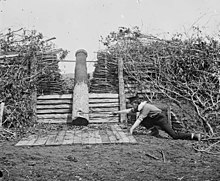Quaker gun


A Quaker gun is a
The original "Quaker gun trick"
During the
Ordered to leave a regular force of colonial
The "Quaker gun trick" worked. Colonel Washington aimed the wooden "cannon" toward the buildings in which the Loyalists had barricaded themselves and threatened to open fire if they did not immediately surrender. Rugeley quickly surrendered his entire force without a single shot being fired.[1]
Use in Europe
During the
Use during the American Civil War

Quaker guns were used by both the North and South in the American Civil War. The Confederate States Army frequently resorted to them because of its shortage of artillery. The wooden guns were painted black and positioned in fortifications to delay Union assaults. Sometimes actual gun carriages were used in the deception.[2]
One notable use of a Quaker gun was by Confederate General Joseph E. Johnston, who placed them in his field works around Centreville, Virginia, in March 1862, to give the appearance that the works were still occupied, while his men were actually withdrawing to the Rappahannock River.[citation needed]
Another example happened during the Siege of Corinth. "During the night of May 29, the Confederate army moved out. They used the Mobile and Ohio Railroad to carry the sick and wounded, the heavy artillery, and tons of supplies. When a train arrived, the troops cheered as though reinforcements were arriving. They set up dummy Quaker guns along the defensive earthworks. Camp fires were kept burning, and buglers and drummers played. The rest of the men slipped away undetected..."[3]
Quaker guns were also used to bolster Confederate fortifications during the Siege of Petersburg. They assisted in prolonging the Confederates' hold on their positions against the overwhelmingly superior numbers of Union troops.[4]
Use during World War I

The widespread adoption of aerial reconnaissance in World War I led both sides to experiment with both deception operations and aerial camouflage.
Use during World War II
A similar idea was employed during the
Similarly, while preparing for the coming
The pre–World War I British battleship HMS Centurion was obsolete and disarmed by World War II. However, from 1942 to 1944, she was fitted with wooden guns and stationed in the eastern Mediterranean, to make British naval forces in the area seem stronger than they were.[citation needed]
Fake gun emplacements, quickly constructed from local timber, were widely employed in the Soviet Union to fool and mislead German
Wooden cannon
Unlike a Quaker gun, a wooden cannon is a functional weapon, albeit notoriously weak and only able to fire a few shots, sometimes even just one shot, before bursting. These were used by those without access to metal or the skill to construct metallic cannons.[7]
See also
Notes
- ^ a b "December of 1780". National Park Service. Archived from the original on March 20, 2015. Retrieved January 7, 2009.
- ^ "Definitions of Civil War terms". Shotgun's Home of the American Civil War. Archived from the original on December 9, 2011. Retrieved January 7, 2009.
- ^ "The Siege and Battle of Corinth: A New Kind of War (Teaching with Historic Places)". NPS. Retrieved May 27, 2020.
- ^ Keperling, D. (April 30, 2013). "Photos from the Civil War". sesquicentennial Archives - Practical Preservation.
- ^ I Could Never Be So Lucky Again, by General James H. "Jimmy" Doolittle, with Carrol V. Glines, p. 228 (Bantum paperback edition, 1991).
- ^ The Guns of Pointe du Hoc as Remembered
- ISBN 9780486433905.
Further reading
- Ripley, Warren (1984). Artillery and Ammunition of the Civil War. Charleston, S.C.: The Battery Press..
- Latimer, Jon (2001), Deception in War, pp. 26–9. London: John Murray. ISBN 0-7195-5605-8.
